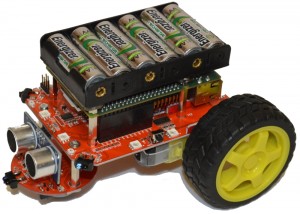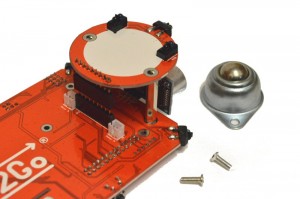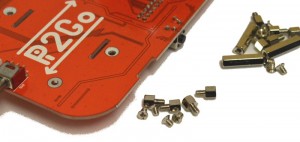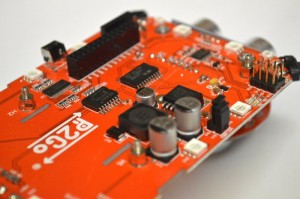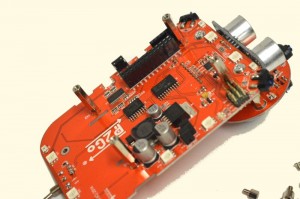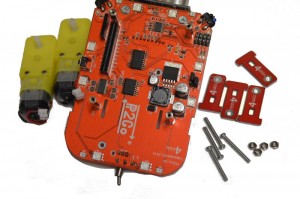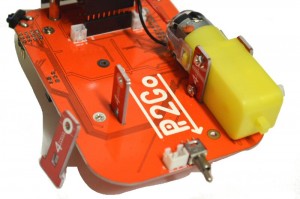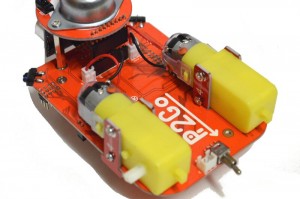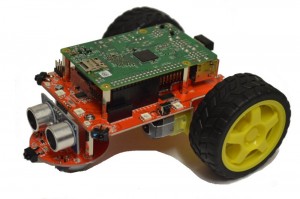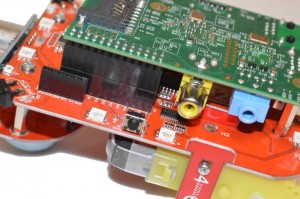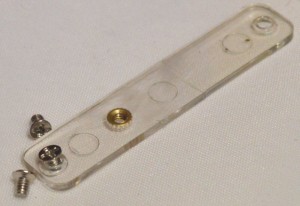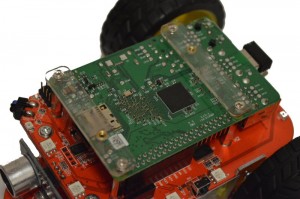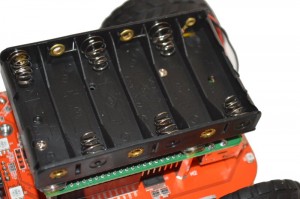Assembling Pi2Go
Pi2Go is the pre-soldered big brother of the popular Pi2Go-Lite kit. Assembly is simply a matter of screwing together and plugging connectors.
Overview of Steps
- Fit the front caster and line following assembly
- Fit the mounting pillars for your chosen Raspberry Pi
- Attach the motors
- Fit the Raspberry Pi
- Fit the battery box
Step 1 – Fit the Front Caster and Line Follower Assembly
You will need the M3 screws, 27mm pillars, ball caster and 9-way extended header and the line follower PCBA
Fit the 2 pillars to the front of the Pi2Go using 2 of the M3 screws
Carefully push in the 9-way header, then attach the line follower PCBA
<photo missing>
Use the remaining 2 screws to attach the ball caster. If there is a bit of slack in its position, ensure that it doesn’t touch the pins of the connector
Step 2 – Fit the Mounting Pillars for Raspberry Pi
For the older Raspberry Pi models with a 26-pin GPIO connector, you will need to fit 2 pillars. For the A+, B+ and RPi 2B you should fit 4 pillars
Fitting the pillars is a 2 step process: 1) fit the small 5mm pillars, 2) screw in the 16mm pillars.
The photo above shows the 5mm pillars in the mounting positions for A+, B+ and RPi 2B models
Use the very small 4mm screws to attach all the pillars. Note that the holes under the motors have been countersunk to allow the motors to sit flat onto the PCBA
The photo above shows the 16mm pillars added for the correct height (A+, B+, RPi 2B)
The photo above shows the 2 pillars in place ready for the Model A or Model B
Step 3 – Attach the Motors
For this you will need 25mm screws, nuts and the motor mounts
Push the screws through the outer motor mount, then the motor, then the inner motor mount and attach to the nuts
Step 4 – Fit the Raspberry Pi
Using the extended header (in the bag with the battery box), connect the Pi onto the Pi2Go PCBA.
NB. Ensure that the mounting holes line up with the pillars! If they don’t then the Pi is not fitted correctly and may be damaged.
The above photo shows the RPi 2B in place. The A+ and B+ fit the same way.
This photo (above) shows a Model B
Step 5 – Fit the Battery Holder
Use the 5mm pillars to attach the Raspberry Pi firmly to the mounting pillars. Use 2 or 4 pillars depending on your model of Pi (RPi 2B shown above)
For the Model A and Model B, you can now screw the battery holder directly to the 2 supporting 5mm pillars
For the A+, B+ and RPi 2B you will need to fix the support plates in place first
Ensure the one at the front has the threaded insert on the left of the Pi2Go and the one at the rear on the right. Also ensure that the wide parts of the mounting holes are at the top so that they can accept the heads of the screws.
Finally, screw in the battery holder using 2 of the very small 4mm screws
Now you can add batteries, software and enjoy!

